In our daily lives, cholesterol is a widely discussed term. Cholesterol is a type of lipid substance that plays an important physiological role in our bodies. It is a colorless, tasteless fat-like substance found in our blood, cells, and tissues. Cholesterol serves various functions in the body, including maintaining the structural integrity of cell membranes, synthesizing hormones, vitamin D, and bile acids.
Cholesterol is actually divided into “good” and “bad” categories.
In the human body, cholesterol is primarily categorized into two types: high-density lipoprotein cholesterol (HDL cholesterol) and low-density lipoprotein cholesterol (LDL cholesterol).
High-density lipoprotein cholesterol (HDL cholesterol): HDL cholesterol is considered “good cholesterol” because it is highly beneficial for our health. HDL cholesterol works by recycling excess cholesterol from tissues and cells back to the liver for metabolism and excretion, removing excess cholesterol from the body. High levels of HDL cholesterol are believed to protect cardiovascular health, reducing the risk of heart disease and stroke.
Low-density lipoprotein cholesterol (LDL cholesterol): LDL cholesterol is known as “bad cholesterol” because high levels of LDL cholesterol increase the risk of atherosclerosis and cardiovascular diseases. LDL cholesterol transports cholesterol to tissues and cells in the blood, but excessive deposition of LDL cholesterol on the blood vessel walls can lead to narrowing of the blood vessels and plaque formation, increasing the risk of heart disease and stroke.
One-fourth of cholesterol is obtained through diet.
According to a study on global cholesterol levels published in the journal “Nature,” there are significant regional differences in global cholesterol levels. In recent years, cholesterol levels in Western countries have shown a declining trend, while cholesterol levels in Asian countries have been continuously rising.
Especially in our country, it is worrisome that the increase in cholesterol levels is exceptionally rapid. In just 40 years, our country’s cholesterol levels have exceeded those of many Western developed countries, making it one of the countries with higher cholesterol levels in the world.
So, why is the increase in cholesterol levels in our country so rapid?
Firstly, changes in dietary structure are a major factor. With the changes in modern lifestyles, dietary preferences of our people have undergone significant changes. Excessive intake of high-calorie foods has become one of the main factors leading to high cholesterol levels. Common foods such as meat, animal organs, fried foods, etc., contain high amounts of saturated fats, and excessive consumption of these foods leads to continuous accumulation of cholesterol.
Secondly, inadequate intake of foods rich in fiber, fruits, vegetables, and vitamins, which contain fiber and antioxidants, is also an important factor. These foods are very beneficial for lowering cholesterol levels, but in modern diets, people often prefer high-calorie, high-fat foods, leading to insufficient intake of dietary fiber and other nutrients, further promoting cholesterol accumulation.
In addition, the influence of modern lifestyles cannot be ignored. With economic development and urbanization, the population of overweight and obese individuals in our country is continuously increasing, and lack of physical activity has become a norm. Sedentary lifestyles, lack of physical exercise, and increased mental stress all contribute to the continuous rise in cholesterol levels.
What to do if you discover high cholesterol and don’t want to take medication?
1. Healthy diet:
Follow a heart-healthy diet, limit intake of high-cholesterol and high-saturated fat foods. Reduce intake of animal fats like red meat, butter, cheese, etc. Increase intake of foods rich in dietary fiber such as fruits, vegetables, whole grains, and legumes.
2. Weight control:
Maintaining a proper weight is critical for lowering bad cholesterol levels. Overweight and obesity increase levels of low-density lipoprotein cholesterol (LDL-C) and decrease levels of high-density lipoprotein cholesterol (HDL-C).
3. Exercise moderately:
Regular aerobic exercise, such as brisk walking, jogging, swimming, etc., helps improve cardiovascular health and lower bad cholesterol levels. Aim for at least 150 minutes of moderate-intensity aerobic exercise each week.
4. Avoid smoking and limit alcohol intake:
Smoking lowers HDL-C levels and increases the risk of cardiovascular diseases. Additionally, excessive alcohol consumption has negative effects on heart health. Therefore, smoking should be quit and alcohol intake should be limited.
5. Control blood pressure and blood sugar levels:
High blood pressure and high blood sugar damage blood vessel linings, promoting the deposition of bad cholesterol and the formation of atherosclerosis. Regularly monitor blood pressure and blood sugar levels, and take appropriate measures to control them.
Note: For high-risk individuals or patients with existing cardiovascular diseases, doctors may consider using medications to lower bad cholesterol levels. Common medications include statins and fibrate drugs


